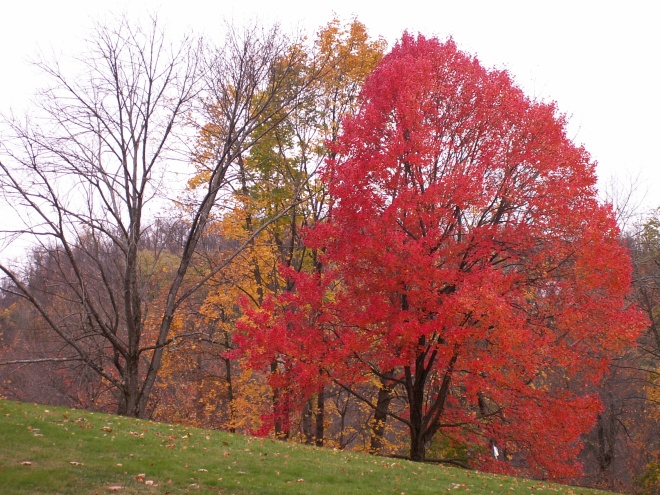-
Patterns in the Woods
-
Art Deco in Knoxville

This little maintenance building on Bausman Street is an unexpected touch of Art Deco in an otherwise residential neighborhood. Enlarge the picture to appreciate the details.
Camera: Konica Minolta DiMAGE Z3.
Update: This building has vanished, so let this picture serve as its memorial.
-
About the Cameras (the original version)
This is the original version of old Pa Pitt’s article about his cameras, just as it was published in 2014. The updated version is here.
Once in a while, people ask old Pa Pitt, “What kind of camera do you use?”
The answer, of course, is complicated.
For practical reasons, Father Pitt has been using digital cameras exclusively for a while now. He would very much like to go back to film, and some day he will, when he has the time. The business of developing the film on the kitchen counter and then scanning the negatives takes a big chunk out of the day, whereas a digital camera takes a picture that can be instantly published.
What Father Pitt has really always wanted is a Kodak Pony with a digital back. The Pony was a simple but well-made camera with no light meter and no rangefinder, so that the photographer had to use his own brain to set the exposure and focus. Old Pa Pitt has gone looking for digital cameras that come closest to replicating that experience—that is, digital cameras that will actually allow him to set the exposure and the focus himself.
Those are harder to find than you might think, especially if you want to pay less than $300. Why? It seems that that market has told camera makers not to offer manual settings in inexpensive cameras—even though it makes no difference in the cost. Manual options used to be much more common, but the market told the camera makers, “Take those horrid things away. They make us feel stupid.” Look on line at user reviews of older cameras: you’ll see many users giving them bad reviews specifically because those options exist.
But digital cameras have been around long enough now that old ones are very cheap. Father Pitt’s very favorite camera came from an on-line auction: it cost him 99¢ plus shipping. He has not spent much more for most of his other cameras. If a camera would cost him more than $20, shipping included, he usually rejects it.
The cameras of ten years ago or so do not have the resolution of today’s cameras, but that does not worry old Pa Pitt very much. Remember that “megapixels” are a measurement of area. A 16-megapixel picture is only twice as wide as a 4-megapixel picture (not four times as wide, as most people seem to assume), and a 4-megapixel picture from a very good camera enlarged to 200% is better than a 16-megapixel picture from this year’s cheap pocket camera. Besides, in a small digital camera, 5 to 8 megapixels is probably the limit of resolution of the lens itself; above that limit, you’re getting more pixels, but not more real resolution. At any rate, a 3-megapixel picture is usually good enough for a full-page picture in a book; 5 megapixels was good enough for the notoriously picky magazine National Geographic.

Canon PowerShot S45. Perhaps the closest old Pa Pitt has come to his ideal of a Kodak Pony with a digital back. It has complete manual control of everything, and it will save pictures in raw mode, like an expensive DSLR. The lens is pretty good for a small camera. The only disadvantages are that it is a little bigger than most pocket cameras, and it uses a Compact Flash card rather than the nearly universal SD Card.

Fujifilm FinePix 2650. Father Pitt’s first digital camera, a simpleminded brick that takes very good pictures (at 2-megapixel resolution), if you forgive strong barrel distortion at the wide-angle end. He does not really use it much anymore, but it still works after twelve years of abuse, which is surprising.

Kodak EasyShare Z1485 IS. [After many years of heavy use, this one finally succumbed to some sort of sensor-scrambling disease. It leaves behind thousands of good pictures.] The Kodak name was poison in the digital-camera market, for no very good reason other than snobbishness. It still is, which means that you can get this camera used much cheaper than other brands with similar features.
This is a pocket camera that’s a bit thicker than most pocket cameras, but it justifies the thickness with extra features. Most important is complete manual control, although photographers will be surprised to learn that there is no aperture-priority or shutter-priority mode—only full manual. At 14 megapixels, it compares favorably in resolution with current digital cameras (the difference between 14 and 16 megapixels is tiny), although Father Pitt does wish it would save its pictures with a little less compression. It takes good movies as well.
This camera has quirks: among others, it eats through batteries quickly, and you can easily outrun the buffer if you shoot several pictures in a row. But its versatility makes it the one camera Father Pitt carries if he has room for only one camera that must fit in the pocket. One can almost always coax a good picture out of it.
It’s one of the ironies of photographic history that Kodak, which invented many of the technologies used in digital cameras today, was unable to survive as a maker of digital cameras. (In the case of this camera, at least, stupid marketing didn’t help: the camera was sold—for close to $400—with a rechargeable battery and no charger, according to many negative on-line reviews. You had to buy the charger separately. Father Pitt bought the camera used with the charger for about $10, so he didn’t have that frustration.) This was one of the last cameras Kodak sold, and by this time the manufacturing had been outsourced. There are still Kodak cameras being produced now, but they are simply cameras from another company that has licensed the “Kodak” name.

Konica-Minolta DiMAGE Z3. “DiMAGE” is a stupid name, but this is Father Pitt’s favorite camera: it cost him 99¢ plus shipping, and it was worth every penny. Complete manual control, a long zoom, and extraordinary speed are among its virtues; and Father Pitt is in awe of its sophisticated mechanical image-stabilization system. He has taken clear hand-held pictures with a half-second exposure. If you are a photographer, chances are pretty good that you simply don’t believe that statement, but old Pa Pitt gives you his word. If you are not a photographer, you will have to take old Pa Pitt’s word for it that a half-second is absurdly long for a hand-held picture. (All the pictures for this article, except for the picture of the DiMAGE itself, were taken with this camera, hand-held, with no flash, at shutter speeds of 1/6 or 1/8 second.) Finally, with no auxiliary lenses, the camera can focus down to less than half an inch. The tiniest flowers can nearly fill the frame.
This camera also has its quirks, and old Pa Pitt would not have you think he recommends it to everyone unreservedly. The camera eats batteries while it’s turned off—but, on the other hand, a fresh set of batteries will take hundreds of pictures, perhaps more than a thousand. The colors have a noticeable shift toward the red, but old Pa Pitt corrects that easily in the GIMP. At any speed higher than ISO 50, there is noticeable noise in the pictures; at ISO 400 the noise is unbearably ugly. But the image stabilization makes it much less necessary to use higher speeds. Father Pitt almost always leaves the camera set to ISO 50.
There is a movie mode as well. The resolution is standard American TV resolution, which is pretty good but not spectacular; but the macro capability of the lens can be used in movies as well, making this the only one of Father Pitt’s cameras suitable for filming the adventures of tiny insects.

Olympus E-20n. Though it has a fixed lens, this is a true DSLR, with an optical viewfinder that uses an unusual prism system to bounce the light into your eye, rather than the usual mirrors. In the hand it feels more like old Pa Pitt’s much-loved Olympus OM-1 than any other digital camera he has, and its manual focus is actually manipulated by a focus ring on the lens, rather than through awkward menus and buttons. There are options within options, and the user interface is unnecessarily complex; but once you have the camera set up the way you want it, it’s very much like an old film SLR. The one glaring problem is the speed: there’s room for four pictures in the buffer, and then you have to wait, and wait, and wait, while the camera writes data on a big chunky Compact Flash card. But the pictures are gorgeous. This is one camera old Pa Pitt actually spent $50 on, and it was worth it. It was originally a $2,000 camera, so you can argue that $50 was quite a bargain. And it looks like a “professional” camera. If it is necessary to establish credibility as a photographer, this thing hanging on one’s neck will do it; then one can slip in any old cheap camera on the plea that one likes to have a backup.
Panasonic Lumix DMC-S3. This is a cheap pocket camera that has one remarkable virtue: a wide-angle lens with almost no distortion at the wide end. It’s about equivalent to a 28mm lens on a 35mm camera, where most cheap zoom lenses are about equivalent to a 35mm lens on a 35mm camera—and most of those lenses show pretty bad barrel distortion at the wide end. (You can see that distortion in some of the pictures on this site, from the time before old Pa Pitt started to put the extra effort into correcting the distortion with the GIMP.) Otherwise, there’s not much to recommend it over any other pocket camera, but that wide-angle lens is very useful for taking pictures of buildings in the narrow streets of Pittsburgh.

Samsung Digimax V4. This is absolutely the slowest digital camera old Pa Pitt has ever used. If he were a sports photographer, he would have left this in the Dumpster behind the stadium, after having pounded it with a brick to show it what he thought of its performance. But since his interest is mostly in things that stand still, he finds his patience rewarded. It fits in the pocket (a bit lumpily); it has a Schneider Kreuznach lens that sees the world clearly; it allows complete manual control of everything; and it can save in uncompressed TIFF format, if you are willing to wait about half a minute between pictures.
This is the quirkiest camera in the bunch by a long shot (so to speak). Besides its glacial speed, it has a distressing ability to overheat itself if it is left on for fifteen minutes or so. If it does, it will simply die, lens extended, and nothing will turn it on or off. Taking the batteries out and putting them back in does not help. But if you take out the batteries and take the camera to a cool, dark room where soothing music is playing, and let it rest on a soft cushion for an hour, then you can put the batteries back in and it will miraculously revive itself.
It is also the only camera on the list whose pictures will not work with the Hugin panorama software. Why not? Father Pitt thinks it may be some curious anomaly in the EXIF data this camera generates.
And yet, with all that, it was still not a very popular camera. Go figure.
New Additions:


Canon PowerShot A Series. When old Pa Pitt heard about the Canon Hack Development Kit, he decided to see what kind of transformation could be wrought upon a little pocket camera. He really wanted only one to play with, but these cameras all came in a box together from an on-line auction. All but the earliest one—the PowerShot A70—have ready-made CHDK software downloads waiting for them.
Just as they come, these are unusually well-specified for pocket cameras. They allow complete manual control of everything, and the pictures are about as good as you can get from a little camera like these.
But CHDK, which you install simply by copying it to an SD card and sticking the card in the camera, adds raw support (in DNG format) and an incredible variety of capabilities, even beyond what you would ordinarily find in many DSLR cameras. Yes, your DSLR has better and more expensive lenses. But can it play Tetris?
-
About the Cameras
Back in 2014, old Pa Pitt published an article about the cameras he uses. That article is long out of date, but for history buffs it still exists here. Meanwhile, here is an updated version.
Sometimes people ask old Pa Pitt what kind of camera he uses. He laughs, of course, because he has bags of cameras. But if you were to press him for a single answer, he would say, “A cheap one.”
Some of these cameras were far from cheap when they were new, but they have not been new for a long time. The newest camera Father Pitt uses is about ten years old. Few of these cameras cost him more than $30; some were much cheaper.
It may be that the older cameras do not have the resolution of current cameras, but that does not worry Father Pitt very much. The notoriously picky magazine National Geographic decided that digital cameras were good enough when they reached five megapixels. Four megapixels will make a respectable full-page picture for a less fussy magazine.
But why dedicated cameras at all? Why not just use a cell-phone camera?
Some phones have very good cameras built into them, but even those lack the versatility of a dedicated camera. It is very hard to find a cell-phone camera whose lens has the range of the lens on even a cheap pocket digital camera. Cell phones are specialized for taking pictures of things close to you, like your dinner or your friend across the table. Nevertheless, the camera you have with you is better than the camera in the bag at home, and Father Pitt will often use a cell phone when opportunities for pictures pop up unexpectedly.
So here are a few of the cameras Father Pitt uses, beginning with an outlier—the most expensive of the bunch.

The Sony Alpha 3000, or α3000, is a “mirrorless interchangeable lens camera,” meaning that it works like a DSLR but lacks the mirror that makes a true reflex. It’s about ten years old, but its image quality is still top-notch. This is the one camera Father Pitt spent money on, though not a whole lot of money. It is also the only one of the lot whose picture was not taken by the Sony Alpha 3000; the Fujifilm HS10 stepped in for this shot.
With an adapter, this camera can take a huge range of lenses from the days of film, though with a “crop factor” of 1.5, meaning that, for example, a 50-millimeter lens covers the same area that a 75-millimeter lens would cover on a 35-millimeter camera (or a digital camera with a “full-frame” sensor). In addition to the standard zoom lens, Father Pitt has an Industar 50mm lens, a Victar 50mm lens, a Wirgin Telepar 105mm lens, and a Vivitar 28mm lens (made by Kino), all of which fit this camera with an M42 adapter. There is also a fast though cheap 7Artisans 35mm lens made for this mount.
When Father Pitt just mentions the “Sony Alpha 3000” in an article, he means that he was using the stock 18–55mm lens that came with the camera, which is a very good lens. He mentions the specific lens when he uses a different one.

This Fujifilm HS10 gets a lot of use, because it is the one camera that can be relied on to come through in almost any situation. It was meant to appeal to the seasoned photographer who needs to have a do-everything camera without the huge lenses a full-size DSLR would need. It has a zoom lens that widens to the equivalent of 24mm in 35mm terms; at the other end, it is the equivalent of a 720mm telephoto. The zoom is controlled manually, not with a motor, which makes it much more precise. There are buttons and dials to control every function. Everything about this camera is just about perfect, in fact, except the camera part. The actual images are mediocre. The lens has strong distortion in both directions (corrected in camera, but very obvious in raw files). The sensor is necessarily small with such a long zoom range, which makes it more susceptible to noise. But a good picture can always be coaxed out of this camera. Shortcomings will be obvious if you enlarge the picture, but for ordinary uses this camera always comes through.

This Fujifilm FinePix HS20 EXR is the successor to the HS10 above. It is a new acquisition, and old Pa Pitt will have more to say about it after he has played with it for a while.

The Nikon COOLPIX P100 is contemporary with the Fuji HS10 above, but not as well specified. Father Pitt has written a whole article about the Nikon COOLPIX P100, so he will simply send you there for more details.

The Kodak EasyShare Z981 is another superzoom, identical in range to the Nikon above and introduced at about the same time. Father Pitt has written an article called “Why We Still Use the Cranky Old Kodak EasyShare Z981,” which explains why he still uses his cranky old Kodak EasyShare Z981.

The Kodak EasyShare Max Z990 feels much more substantial than the Z981 above. It is otherwise what Father Pitt has come to expect from top-of-the-line Kodak cameras: a third-rate camera with a first-rate German lens in front of it. The Schneider lens has a long reach, and much less distortion than most superzoom lenses.
The camera is slow. You wouldn’t notice it as much if you were saving JPEGs, but Father Pitt likes to have the raw data, which this camera is happy to provide—but at the cost of a 12-second wait between shots. Well, that just makes photography a more contemplative experience. The resolution is 12 megapixels (plus, for some reason, eight more pixels horizontally, making the pictures 4008 x 3000 pixels), which is a little bit less than the resolution of the Z981 above, but not significantly. Father Pitt wishes it had settled for a base speed of ISO 64, like the Z981. The lowest speed is ISO 125, and at that speed noise is noticeable. It can be tamed in software, however, and the lens is worth putting up with the other quirks, including an arcane menu system that will take some getting used to.

The Kodak EasyShare Z1285 is a pocket camera designed for serious photographers, but with the Kodak name as a deterrent to anyone who wants to be taken seriously. It suffers from the same autofocus problems as the Z981 above, and it is easy to outrun the buffer if you have the camera set to bracket exposures. But, on the other hand, it’s a pocket camera that can be set to bracket exposures. It also takes gorgeous pictures at ISO 64. And its resolution is exactly 12 megapixels at a 4:3 ratio, which means that the pictures are exactly 4,000 by 3,000 pixels. That is intellectually satisfying. The pictures are usually perfectly exposed without resorting to manual exposure—but you can resort to manual exposure for night shots or other tricky situations. The Schneider lens is better by far than the average pocket-camera lens. Father Pitt found this camera in a thrift store for $5. It was worth every penny. It replaced a very similar Kodak EasyShare Z1485, identical in most ways except for a slightly higher 14-megapixel resolution, which finally succumbed to some sort of sensor-scrambling disease after taking tens of thousands of pictures.

The Canon PowerShot SX150 IS is an almost-pocket camera—certainly small enough for a jacket pocket, but a little too lumpy for a shirt pocket. It has a pretty long lens for such a small camera, and it allows manual control over most things, although manual focus is a little difficult without a viewfinder. It is a very good camera to have if you want a long range in a jacket pocket. It is also a Canon, and Canons can be hacked: the Canon Hack Development Kit adds a wealth of features normally found on much more expensive cameras. Father Pitt generally uses only three of them, but they are very good things to have: saving raw files, “zebra mode” (which highlights areas that will be overexposed), and exposure bracketing.

This is the 99¢ camera—a Konica Minolta DiMAGE Z3, which Father Pitt bought years ago from an online auction for 99¢ because it was listed as “for parts or not working.” The seller said everything else worked fine, but it wouldn’t read SD cards. It was easy to guess the problem: cameras as old as this one can’t read a card above 2 GB. This camera focuses down to 1 cm, or less than half an inch, which made it Father Pitt’s favorite camera for botanizing for many years. It is also very fast: it fires off three bracketed exposures in the time it takes most of these cameras to take one picture and start to think about getting ready for the next. The resolution is 4 megapixels, which isn’t large, but is good enough for a full page in a magazine. It does have a strange tendency to drift into the orange range unless it is manually white-balanced—but, since it gives you manual control of everything, manual white-balancing is a simple matter of carrying a sheet of copy paper and telling the camera “This is white” at the beginning of a session. The only other problem with this camera is that it gets so much use that it is physically tired. The latch on the battery door broke a couple of years ago, but it still works held together with a rubber band. Nevertheless, Father Pitt went looking for a replacement and found…

Son of 99¢ Camera. This Konica-Minolta DiMAGE Z6 was listed as “for parts or not working” because it wouldn’t read memory cards, but Father Pitt had a guess about what that meant. It has almost all the same features as the Z3, but a better electronic viewfinder, larger rear LCD (though still small by later standards), and 6-megapixel resolution. It’s a little slower, probably because it has to write larger files with the same hardware. But it’s still quite fast. In other respects, it is almost identical to its ancestor, but two things have changed. For some reason, the maximum movie resolution is lowered: the Z3 did movies at standard TV resolution of 640 x 480, but this one only does low-resolution movies at 320 x 240. The other odd change is that the range of exposure bracketing is narrower: the maximum here is half a stop in either direction, rather than the full stop the Z3 could do.
Both of these cameras have the best image stabilization old Pa Pitt has ever used in any camera. They will often produce tack-sharp pictures at the long end of the zoom in dim light with ridiculously slow shutter speeds.

The Olympus E-20N is the oldest digital camera Father Pitt owns, and the only true DSLR in the lot. But it is a very quirky DSLR. It was released in 2001, and it was an attempt to solve the problems photographers had already identified with DSLRs: mechanical complexity and dirty sensors. Instead of a mirror that has to flip out of the way when you take a picture, this one has a split-beam prism that stays in one place but directs light both to the sensor and to the viewfinder. That means you can look through the viewfinder and have the LCD going at the same time—something that wouldn’t be possible with any other DSLR for years. Another benefit is that it eliminates a lot of mechanical complexity and the somewhat violent movement of the mirror. The camera has a fixed lens (with wide-angle and telephoto converters available), instead of interchangeable lenses: the idea was to give the camera a first-rate lens that would cover most situations, thus eliminating the opportunity for filth that comes with changing lenses. It’s a very fast lens and a very good one, but professional photographers like their bags of lenses, and at $2,000 (in 2001) this camera needed a professional audience. You can probably guess that old Pa Pitt didn’t pay that much for it. Except for losing its leatherette around the grip, which got sticky and flakey, so that Father Pitt finally took it off altogether, the camera is in very good shape, and it takes fine pictures at 5-megapixel resolution—good enough for National Geographic.

The Sony Cyber-shot DSC-S90 is a well-specified pocket camera with manual controls and a Zeiss lens. Its 4.1-megapixel resolution is adequate for anything Father Pitt wants to do with it, so it is a good choice for a shirt pocket when he wants to travel light. Like most older pocket digital cameras, it has a simple optical viewfinder inherited from its film ancestors, which is a great help in bright light when the LCD is hard to see. This was another thrift-store find; it cost less than $5.

The Canon PowerShot S45 is perhaps the closest old Pa Pitt has come to his ideal of a Kodak Pony with a digital back. It has complete manual control of everything, and it will save pictures in raw mode, like an expensive DSLR. The lens is pretty good for a small camera. The only disadvantages are that it is a little bigger than most pocket cameras, and it uses a Compact Flash card rather than the nearly universal SD Card.

The Samsung Digimax V4 is absolutely the slowest digital camera old Pa Pitt has ever used. If he were a sports photographer, he would have left this in the Dumpster behind the stadium, after having pounded it with a brick to show it what he thought of its performance. But since his interest is mostly in things that stand still, he finds his patience rewarded. It fits in the pocket (a bit lumpily); it has a Schneider-Kreuznach lens that sees the world clearly; it allows complete manual control of everything; and it can save in uncompressed TIFF format, if you are willing to wait about half a minute between pictures.
Besides its glacial speed, this camera has a distressing tendency to overheat itself if it is left on for fifteen minutes or so. If it does, it will simply die, lens extended, and nothing will turn it on or off. Taking the batteries out and putting them back in does not help. But if you take out the batteries and take the camera to a cool, dark room where soothing music is playing, and let it rest on a soft cushion for an hour, then you can put the batteries back in and it will miraculously revive itself.
These days Father Pitt leaves this camera set to black-and-white mode, making it the moral equivalent of a Leica Monochrom, if the Leica had a tiny 4-megapixel sensor.


Canon PowerShot A Series. When old Pa Pitt heard about the Canon Hack Development Kit, he decided to see what kind of transformation could be wrought upon a little pocket camera. He really wanted only one to play with, but these cameras all came in a box together from an on-line auction. All but the earliest one—the PowerShot A70—have ready-made CHDK software downloads waiting for them. Two of them wore out after ten years of use, but the A540 still lives in the car as the frequently used emergency camera.
Just as they come, these are unusually well-specified for pocket cameras. They allow complete manual control of everything, and the pictures are about as good as you can get from a little camera like these.
But CHDK, which you install simply by copying it to an SD card and sticking the card in the camera, adds raw support (in DNG format) and an incredible variety of capabilities, even beyond what you would ordinarily find in many DSLR cameras. Yes, your DSLR has better and more expensive lenses. But can it play Tetris?
-
Another Groundhog Eating an Acorn
-
A Ginkgo Drops Its Leaves
A Ginkgo biloba has just dropped its leaves in the Union Dale Cemetery. Ginkgo biloba is an odd tree in almost every respect, and this is one of its odd habits. Most trees lose their leaves over the course of a few days, but a Ginkgo loses them in a surprisingly short time, almost all at once. If there is not much wind, the result is a rich golden carpet with the tree at the center of it.
-
Last Burst of Color in West End Park
-
The Great Floyd Gun, Cast at the Fort Pitt Foundry, Pittsburgh
From Frank Leslie’s Illustrated Newspaper, February 25, 1860. —Knapp, Rudd, & Co. cast this thing, which was considered one of the wonders of the age.
-
Old Stone Church, Monroeville

This church is not all that old, having been built in 1896; but it sits on a site where there has been a church since 1834, and a burying-ground since 1796. The Cross Roads Presbyterian Church has moved to a much larger building some distance away, but still maintains the cemetery. The borough owns this building, and the Monroeville Historical Society uses it.
The bell tower was added in 1976; it is dedicated to George Westinghouse and Nikola Tesla. Father Pitt has not researched the subject thoroughly, but he suspects that this is the only bell tower in the world dedicated to Nikola Tesla.

-
Steller’s Sea Eagle at the National Aviary







